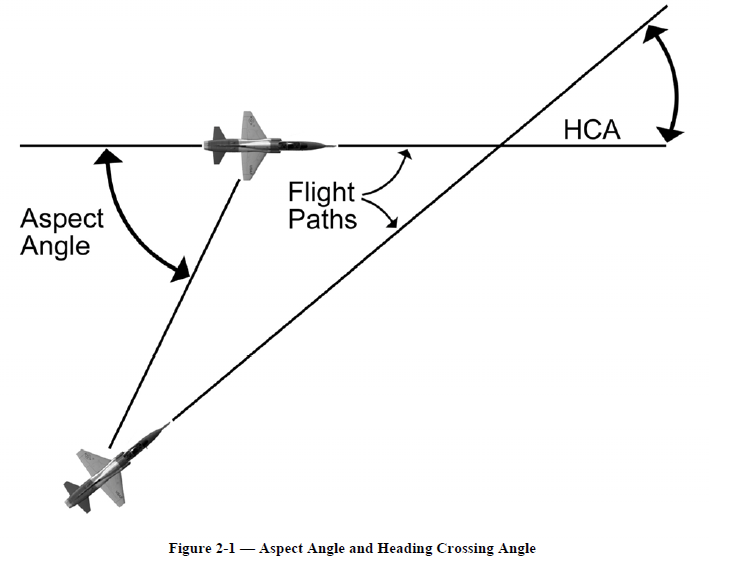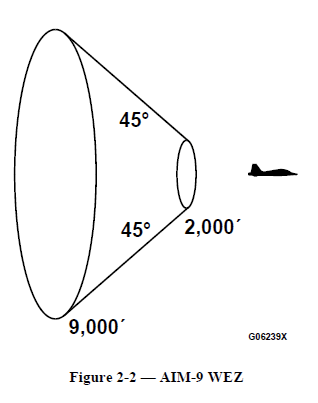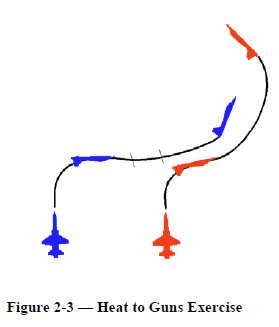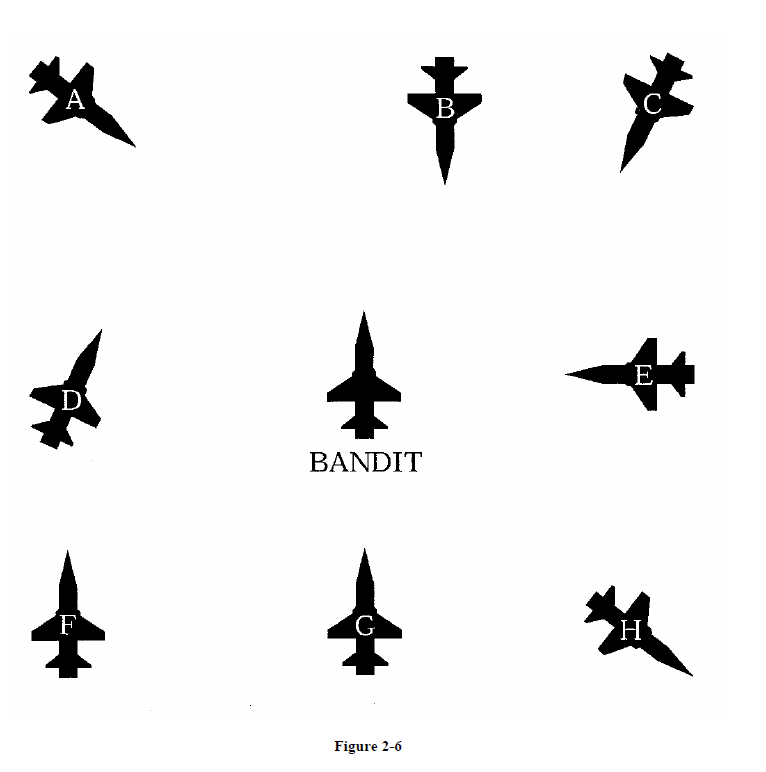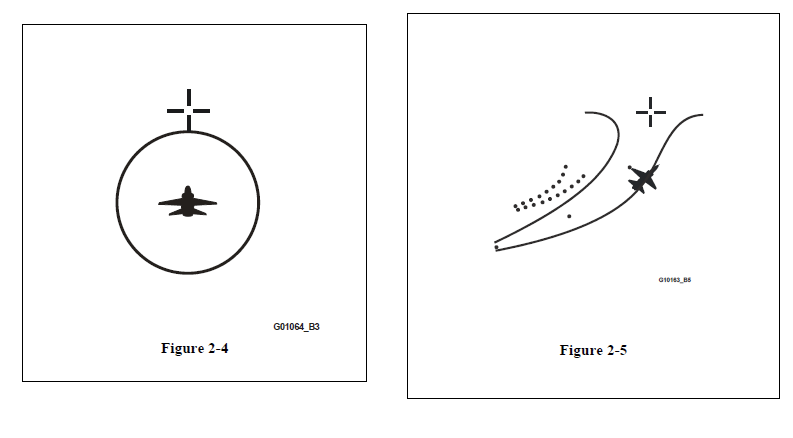AA-2 Systems and Exercises
Objectives
1. RangeUnderstand /the range/mil relationshipsrelationship.
2. AspectUnderstand angleaspect /angle.
3. Understand heading crossing angle (HCA).
4. Understand weapons parameters and valid shot requirements.
5. Describe the heat to guns exercise.
Assignment
1. Review Lesson AA-2 in the Basic Fighter Maneuvers Student Guide, B/F-V5A-K-AA-SG.
2. Review MCMAN 11-238, Vol 2, Chapters 1 – 3, through Pursuit Curves.
3. Review T.O.1T-38C-34-1-1.
Information
Range and Mil Relationship
Objective 1 — Understand the range/mil relationship.
1. How do you aim to kill?
2. Milliradian (mil) is an angular measure.
a. One radian = 57.3° (approximately)
b. One mil = radian ÷ 1,000 = 0.057°
c. One degree = 17.45 mils
d. One mil = arc length ÷ range
e. Range can be any unit: foot, meter etc.
f. Example: 1 mil = 3 feet at 3,000 ft or 3 meters at 3,000 meters
3. Range and mils.
a. Range = Wingspan/mils X 1,000.
b. Mils = Wingspan/range X 1,000.
c. What is the range of a T–38 that subtends 10 mils? Range = 25 ÷ 10 X 1,000 = 2,500 ft
d. How many mils will a T–38 subtend at 1,000 feet? Mils = 25 ÷ 1,000 X 1,000 = 25
4. Sight Picture T–38C
a. How big is a T–38 at minimum gun range? Mils = 25 ÷ 1,000 X 1,000 = 25 (LCOS outer circle or top range
reference cue (dot) on FNNL).
b. How many mils will a T–38 subtend at max gun range? Mils = 25 ÷ 2,500 X 1,000 = 10.0 (LCOS inner circle
or middle range reference cue on FNNL).
Aspect Angle
Objective 2 — Understand aspect angle
1. Aspect angle — Attacker’s position relative to the defender’s 6 o’clock (Figure 2-1).
a. Each clock position is 30° of aspect.
b. Aircraft heading has no affect on aspect angle.
c. Aspect is symmetric about the targets 6/12 line, i.e., 30° left versus 30° right.
Heading Crossing Angle (HCA)
Objective 3 — Understand heading crossing angle.
1. Heading Crossing Angle (HCA) — Angular difference between the longitudinal axis of the attacker and the
defender (Figure 2-1).
a. In level flight heading crossing angle is the difference in 2 aircraft headings. HCA is sometimes called
Angle–Off.
b. Heading has no meaning straight up or down, but the longitudinal axis definition is still valid.
c. Aspect does not affect HCA.
Weapons Employment Zone
Objective 4 — Understand weapons parameters and valid shot requirements.
1. Gun weapon employment zone (WEZ)(simulated 20 mm cannon)
a. 1,000 ft min range is training rule.
b. 2,500 ft max range is a convenient ballistic average for shots between 0 and 90° aspect.
c. Maximum aspect angle of 135°, as per training rule.
2. Gunshot requirements
a. In–Range — Range to target is a function of range, aspect, and closure.
b. In–Plane — Provides the highest probability of kill (PK). Shooting out–of–plane reduces the PK but may still
be valid
c. Lead — You must shoot ahead of the target to allow for gravity drop, target motion, and bullet time of flight.
You need approximately 30 mils of lead for each target–G.
3. HUD funnel (FNNL) gunsight references for valid kill in IFF:
a. Range and Aspect IAW IFF Syllabus (≤ 2500’ and aspect up to 135°)
b. Lead required: When FEDS line passes target at corresponding wingspan
c. Any part of target in the center of the FEDS counts for 1 frame
d. Target centered in FEDS counts for 2 frames.
(1) One (1) frame required for valid Snapshot.
(2) Fifteen (15) frames is a KILL (frames do NOT have to be consecutive)
4. Heat-to-gunsHUD /LCOS gunsight references (diameter in mils and approximate range based on 25 ft wingspan):
a. LCOS outer circle = 25 mils (1,000 ft)
b. LCOS inner circle = 10 mils (2,500 ft)
c. AIM-9 FOV circle = 35 mils (2° circle)
d. Boresight cross = 13 mils (1,900 ft)
5. AIM-9 WEZ (Figure 2-2)
a. Min range 2,000 ft to allow for fuze arming
b. Max range 9,000 ft for kinematic envelope
c. The shooter can be in any bank attitude and does
not have to be in the target plane of motion because the
missile is guided.
d. Range/aspect are the same for a maneuvering or
nonmaneuvering target for simplicity.
6. AIM-9 shot requirements
a. In the weapons parameter zone (range/heading
crossing angle)
b. Reference target in the missile seeker field of view.
The missile has approximately 2° field of view or 1°
radius (17.45 mils).
c. Sun NOT in HUD FOV at pickle.
d. No flares in FOV at pickle and for TOF (plus 1 second per 1000’ of range).
e. Track the target. The target must be in the seeker field of view at pickle and for ⅓ second (post pickle) to
allow time for the missile to come off the rail.
7. AIM-9 operating modes:
a. Caged: Only looks straight ahead (2°). IFF AIM-9 boresight employment criteria is caged.
b. Slaved: Points at and sees targets provided by aircraft radar (gimbal limits).
c. Uncaged: Can see and track targets out to gimbal limits of seeker cranium.
Heat to Guns Exercise
Objective 5 — Describe the heat to guns exercise.
1. Exercise goals — The student will maneuver from line abreast,
tactical formation to the AIM-9 WEZ and follow–on gun WEZ
(Figure 2-3).
2. Heat–to–guns execution
a. Start with proper parameters!
b. As target turns away from attacker, the attacker performs a max
performance turn into the target.
c. As your turn brings the target toward the “FOV circle” ease off
the turn and put the target in the seeker field of view and pickle (track
for ⅓ second post pickle).
d. After the Fox II, the attacker will reposition to the guns WEZ and
practice gun employment (pursuit curves are discussed further in
Offensive Maneuvering).
e. Gun track 1,000 — 2,500 ft, inside the funnel in–plane or with pipper on target in–plane at the same ranges.
Control closure and maintain 1,000 ft bubble awareness.
3. Heat–to–guns errors
a. Improper starting parameters, switchology
b. Improper LV, G, power control
c. Invalid Fox II
d. Continues to point at target after Fox II
e. Fails to control closure during reposition to guns or stagnates.
f. Fails to avoid jetwash and/or target bubble
g. Unstable/poor target tracking
4. BFM cross-check
a. A good BFM cross-check includes the ability to analyze airspeed, G, altimeter and lift vector relative to the
bandit.
Review Exercise 2
Complete the following review exercise. Answers are in the back of the SG.
1. Given low aspect and one-third second tracking exercisetime, the Fox II shot illustrated in Figure 2-4 is
a. Valid.
b. Not valid due to
2. With FNNL as the selected gunsight, the gun shot illustrated in Figure 2-5 is
a. Valid.
b. Not valid due to
3. The 25-foot wingspan of a T–38C is how many mils at the following ranges?
6,000 ft __________ 2,500 ft __________
5,000 ft __________ 1,250 ft __________
4,000 ft __________ 1,000 ft __________
3,000 ft __________
4. What is the aspect and heading crossing angle (HCA) of each T-38 in Figure 2-6 in relation to the bandit in the
center?
5. FENCETrue checkor False: Aspect angle always equals heading crossing angle (HCA) when pointing at the bandit.
6. The heat to guns exercise goal is to _________________________.

